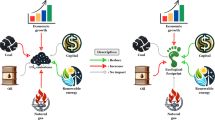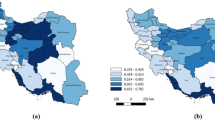Abstract
Over the last decade the residential electricity price in most EU Member States has been increasing. Even after the introduction of significant reforms such as the liberalisation of the electricity market. This upward trend is in response to the development of different price components along the electricity supply chain. In order to identify and analyse these components for EU-Member States, a more detailed price apportionment than those offered by public sources like Eurostat and IEA is necessary. The methodology proposed in this study analyses the development of the residential electricity price and its main components between 2002 and 2012 for Germany, France, Italy and the United Kingdom. The main drivers of the price trends observed for these four countries are subsequently identified, quantified and compared. Furthermore, the residential expenditure on electricity in each country is examined in connection with the evolution of residential electricity consumption. The results show how and to what extent the residential electricity price for the selected EU Member States depends on price components such as the electricity wholesale price, the gross margin, network expenditures, energy taxes and other levies related to the decarbonisation of the national energy system. Furthermore, this detailed analysis of residential electricity prices throughout the last decade provides a sufficient data basis to draw some prospective conclusions in terms of a short-term price outlook.
Zusammenfassung
Der Haushaltsstrompreis ist in den meisten EU-Mitgliedsstaaten in den letzten zehn Jahren gestiegen – selbst nach grundlegenden Reformen wie der Liberalisierung des Strommarktes. Dieser Trend ist auf die Entwicklung der verschiedenen Preisbestandteile entlang der Strom-Lieferkette zurückzuführen. Um diese Komponenten des Haushaltsstrompreises für die EU-Mitgliedstaaten zu identifizieren und zu analysieren, ist eine detailliertere Aufschlüsselung des Preises erforderlich als sie von den öffentlichen Quellen wie Eurostat und IEA bereitgestellt wird. Die in dieser Studie vorgeschlagene Methodik ermöglicht die Entwicklung des Haushaltsstrompreises und seiner wichtigsten Komponenten zwischen 2002 und 2012 für Deutschland, Frankreich, Italien und Großbritannien zu analysieren. Ausgehend von den Ergebnissen dieser Analyse werden die wichtigsten Einflussfaktoren der Preisentwicklung für diese vier Länder identifiziert, quantifiziert und verglichen. Darüber hinaus werden die Stromausgaben in den einzelnen Ländern im Zusammenhang mit der Entwicklung der Strompreise untersucht. Die Ergebnisse zeigen, in welcher Form und in welchem Umfang die Haushaltsstrompreise für Deutschland, Frankreich, Italien und Großbritannien von den einzelnen Preisbestandteilen abhängen wie dem Strom-Großhandelspreis, der Bruttomarge, Netzentgelte, Energie-Steuern und andere Abgaben im Zusammenhang mit der Dekarbonisierung des nationalen Energiesystems. Des Weiteren bietet diese detaillierte Analyse von Strompreisen für den Haushaltssektor über die letzten zehn Jahre eine umfassende Datengrundlage um prospektive Aussagen hinsichtlich eines kurzfristigen Preisausblicks zu treffen.








Similar content being viewed by others
Notes
The Renewable Energies Act levy (EEG-Umlage in German) is a political instrument to promote the production of energy from renewable sources in Germany. For more information about this levy see ÜNB (2012).
Since 2011 retail companies benefit to a limited extent from the NOME law (“Nouvelle Organisation du Marché de l’Electricité”) which requires the main utility supplier EDF to sell 100 TWh of its production at a fixed rate to competing retail companies (Ministère de l’écologie 2010). This price is not considered in this study.
The CPI is part of the national statistics published by EU Member States.
This does not necessarily mean that the installation of renewable energy sources (RES) increased the electricity price by 16 %, since RES contribute likewise to a reduction in wholesale prices, which is also known as the merit order effect (Sensfuß et al. 2008).
As explained in chap. 2, data on electricity consumption after 2010 were not available at the moment of elaborating this study.
Von der Fehr and Hansen (2010) state that passive consumers not switching their supplier often pay prices far more expensive than the cheapest available rates.
References
Arbeitsgemeinschaft Energiebilanzen e. V (2013) Daten. Energiebilanzen. http://www.ag-energiebilanzen.de/viewpage.php?idpage=6. Accessed 17 July 2013
Autorità per l'energia elettrica e il gas (2013) Elettricità. Prezzi e tariffe. http://www.autorita.energia.it/it/consumatori/consumatori_ele.htm. Accessed 17 July 2013
Axpo IItalia (2013) Energy Mix disclosure 2013. http://www.axpo.com/axpo/it/en/knowledge/energy-mix.html. Accessed 17 July 2013
Balcerowiak R (2012) Die Zukunft armer Haushalte sieht düster aus. http://www.neues-deutschland.de/artikel/807967.die-zukunft-armer-haushalte-sieht-duester-aus.html. Accessed 16 July 2013
BDEW (2011) Erneuerbare Energien und das EEG in Zahlen (2011). Anlagen, installierte Leistung, Stromerzeugung, EEG-Vergütungssummen, Marktintegration der erneuerbaren Energien und regionale Verteilung der EEG-induzierten Zahlungsströme. http://www.bdew.de/internet.nsf/id/3564E959A01B9E66C125796B003CFCCE/$file/BDEW%20Energie-Info_EE%20und%20das%20EEG%20(2011)_23012012.pdf. Accessed 29 Nov 2012
BDEW (2013) BDEW-Strompreisanalyse Mai 2013—Haushalte und Industrie. https://www.bdew.de/internet.nsf/id/123176ABDD9ECE5DC1257AA20040E368/$file/13%2005%2027%20BDEW_Strompreisanalyse_Mai%202013.pdf. Accessed 17 Jul 2013
BMU (2012) Bundesumweltministerium: Gesetz für den Vorrang Erneuerbarer Energien (Erneuerbare-Energien-Gesetz: EEG). http://www.erneuerbare-energien.de/fileadmin/ee-import/files/pdfs/allgemein/application/pdf/eeg_2012_bf.pdf. Accessed 02 Feb 2013
Boardman AE (2011) Cost-benefit analysis. Concepts and practice, 4th edn. The Pearson series in economics. Prentice Hall, Upper Saddle River
Bundesnetzagentur (2012) Berichte der Bundesnetzagentur (1999–2012). Monitoringbericht. http://www.bundesnetzagentur.de/cln_1912/DE/Presse/Berichte/berichte_node.html;jsessionid=205402026C18007016388043AE723FDC. Accessed 16 Jan 2013
Buttermann HG, Hillebrand B, Baten T (2008) Determinanten der Strom-und Gaspreisentwicklung in Deutschland—Eine empirische Bestandsaufnahme für die Jahre 1998 bis 2007. Z Energiewirtsch 32(3):187–196. doi:10.1007/s12398-008-0024-3
Commission de régulation de l'énergie (2013a) Marché de l’électricité. Marché de détail. http://www.cre.fr/marches/marche-de-detail/marche-de-l-electricite. Accessed 17 July 2013
Commission de régulation de l'énergie (2013b) Observatoire et indicateurs des marchés. http://www.cre.fr/marches/observatoire-et-indicateurs-des-marches. Accessed 17 July 2013
Commission de Régulation de l’Électricité et du Gaz (2010) Study (F)101007-CDC-995. The comparison of electricity prices for a household consuming 3,500 kWh grey electricity (single tariff) in Brussels, Paris, Berlin, Amsterdam and London. http://www.creg.info/pdf/Etudes/F995ENG.pdf. Accessed 29 Nov 2012
Connaissance des énergies (2012) An overview of Italy’s energy mix. http://www.connaissancedesenergies.org/sites/default/files/pdf-pt-vue/ifri_anoverviewofitalysenergymixifriversion13062012.pdf. Accessed 17 July 2013
Cruciani M (2011) Evolution des prix de l'électricité aux clients domestique en Europe occidentale. http://www.ifri.org/?page=detail-contribution&id=6889. Accessed 17 Jul 2013
Darby SJ (2012) Metering: EU policy and implications for fuel poor households. Energ Policy 49:98–106. doi:10.1016/j.enpol.2011.11.065
Department of Energy & Climate Change in UK (2013a) Fuel poverty report: annual report on statistics 2013. https://www.gov.uk/government/publications/fuel-poverty-report-annual-report-on-statistics-2013. Accessed 16 July 2013
Department of Energy & Climate Change in UK (2013b) Quarterly energy prices. https://www.gov.uk/government/organisations/department-of-energy-climate-change/series/quarterly-energy-prices. Accessed 17 July 2013
Department of Energy & Climate Change in UK (2013c) UK energy statistics. Statistical press release. https://www.gov.uk/government/news/uk-energy-statistics-statistical-press-release. Accessed 17 July 2013
Department of Energy & Climate Change in UK and Ofgem (2013) Electricity network delivery and access. https://www.gov.uk/electricity-network-delivery-and-access. Accessed 17 July 2013
Destatis (2012) Verbraucherpreisindizes für Deutschland- Eilbericht -. https://www.destatis.de/DE/Publikationen/Thematisch/Preise/Verbraucherpreise/VerbraucherpreiseMEPDF/VerbraucherpreiseME2170700122084.pdf?__blob=publicationFile. Accessed 28 Jan 2013
EDF (2010) Qu’est-ce que la Contribution Tarifaire d’Acheminement (CTA)? http://entreprises.edf.com/le-mag-de-l-energie/actualites-et-temoignages/actualites-edf-entreprises/qu-est-ce-que-la-contribution-tarifaire-d-acheminement-cta-y-47004.html. Accessed 16 Jan 2013
EEX (2013) European Energy Exchange (EEX). http://www.eex.com/. Accessed 16 Jan 2013
Enel (2010) Tariff regulation in Italy. http://www.fstrf.ru/eng/international_activity/meropr/4/4/1/03_-_Tariff_regulation_in_Italy__marco_massimiano_giulio_del_gobbo.pdf. Accessed 16 July 2013
Enel (2013) Imposte gravanti sull’energia elettrica. http://www.enel.it/it-IT/clienti/enel_servizio_elettrico/imposte_info/. Accessed 17 July 2013
Enerdata (2013) Energy efficiency database. http://www.enerdata.net/enerdatauk/solutions/data-management/odyssee.php. Accessed 17 July 2013
Energy Saving Trust (2013) Carbon Emissions Reduction Target (CERT). http://www.energysavingtrust.org.uk/Organisations/Government-and-local-programmes/Free-resources-for-local-authorities/Local-authority-funding-guide/Funds/Local-Authorities/Carbon-Emissions-Reduction-Target-CERT. Accessed 17 July 2013
EnergyWatchGroup (2013) Fossil and nuclear fuels—the supply outlook. Energy Watch Group, Berlin, Germany
European Commission (2009) Directive 2009/72/EC of the European Parliament and of the Council of 13 July 2009 concerning common rules for the internal market in electricity and repealing Directive 2003/54/EC
European Commission (2011a) Italy—energy market fact sheet. http://ec.europa.eu/energy/gas_electricity/doc/it_energy_market_2011_en.pdf. Accessed 29 July 2012
European Commission (2011b) United Kingdom—energy market fact sheet. http://ec.europa.eu/energy/gas_electricity/doc/uk_energy_market_2011_en.pdf. Accessed 29 July 2012
European Commission (2013a) Eurostat (statistical database). Energy. http://epp.eurostat.ec.europa.eu/portal/page/portal/energy/data/database. Accessed 16 July 2013
European Commission (2013b) Market observatory & statistics. Quarterly reports on European electricity markets
European Commission (2013c) Quarterly report on European gas markets. Volume 6, Issue 2. Second quarter 2013
European Commission (2013d) Energy: action plans & forecasts. http://ec.europa.eu/energy/renewables/action_plan_en.htm. Accessed 16 Jan 2014
European Communities (2008a) Quarterly report on European electricity markets. Volume 1, Issue 1.
European Communities (2008b) Quarterly report on European electricity markets. Volume 1, Issue 2.
European Communities (2009a) Economic crisis in Europe. Causes, consequences and responses. Office for Official Publications of the European Communities, Luxembourg
European Communities (2009b) Quarterly report on European electricity markets. Volume 1, Issue 3.
Frontier Economics (2010) Energiekosten in Deutschland -Entwicklungen, Ursachen und internationaler Vergleich (Projekt 43/09). Endbericht für das Bundesministerium für Wirtschaft und Technologie. http://www.bmwi.de/DE/Mediathek/publikationen.html? Accessed 15 Jan 2013
Holler J, Haberfellner M (2006) Divergenz oder Konvergenz europäischer Großhandelsmärkte? Preisentwicklung am Spotmarkt. E-control Working paper Nr. 17. http://www.e-control.at
Hough D, Bolton P, Richards P (2012) Carbon Emissions Reduction Target (CERT). http://www.parliament.uk/briefing-papers/SN06196. Accessed 17 Jul 2013"
ICIS (2013) European carbon prices to double by end of 2015 following back-loading implementation. Press release. http://www.icis.com/press-releases/european-carbon-prices-to-double-by-end-of-2015-following-back-loading-implementation/. Accessed 16 Jan 2014
IEA (2013a) Energy prices and taxes, 4th Quarter 2012. IEA, Paris, France
IEA (2013b) Medium-term coal market report 2013. IEA, Paris, France.
Jalsovec A (2012) Steigende Energiepreise—Ohne Geld kein Strom. http://www.sueddeutsche.de/geld/steigende-energiepreise-ohne-geld-kein-strom-1.1291078. Accessed 16 July 2013
Kondziella H, Müller B, Bruckner T (2011) Preisdeterminanten des Stromgroßhandels in Frankreich. Z Energiewirtsch 35(4):239–248. doi:10.1007/s12398-011-0052-2
Ministère de l’écologie (2010) Loi n° 2010-1488 du 7 décembre 2010 portant nouvelle organisation du marché de l’électricité
OECD (2011) OECD Factbook 2011-2012. OECD Publishing
Ofgem (2009) Liquidity in the GB wholesale energy markets. Discussion Paper. https://www.ofgem.gov.uk/.../liquidity-gb-wholesale-energy-markets.pdf †. Accessed 17 July 2013
Ofgem (2013a) Renewables Obligation. http://www.ofgem.gov.uk/Sustainability/Environment/RenewablObl/Pages/RenewablObl.aspx. Accessed 17 July 2013
Ofgem (2013b) Retail market review. Electricity and gas supply market indicators. http://www.ofgem.gov.uk/Markets/RetMkts/rmr/smr/Pages/indicators.aspx. Accessed 17 July 2013
Ofgem (2013c) The final report of the Carbon Emissions Reduction Target (CERT) 2008–2012. http://www.ofgem.gov.uk/Pages/MoreInformation.aspx?docid=273&refer=Sustainability/Environment/EnergyEff. Accessed 17 July 2013
Ofgem (2013d) Updated household energy bills explained. https://www.ofgem.gov.uk/ofgem-publications/64006/householdenergybillsexplainedudjuly2013web.pdf. Accessed 17 Jul 2013
Pond R (2009) Liberalisation, privatisation and regulation in the UK electricity sector. Country report on liberalisation and privatisation processes and forms of regulation. http://www.pique.at/reports/pubs/PIQUE_CountryReports_Electricity_UK_November2006.pdf. Accessed 17 July 2013
Seeliger A, Perner J, Riechmann C, Trhal N, Fürsch M, Nagl S, Lindenberger D (2011) Energy costs in Germany—developments, drivers and international comparison. Z Energiewirtsch 35(1):43–52. doi:10.1007/s12398-011-0042-4
Sensfuß F, Genoese M, Ragwitz M (2008) The Merit-order effect: A detailed analysis of the price effect of renewable electricity generation on spot market prices in Germany. Energy Policy 36(8):3076–3084
Sheffield Energy Resources Information Services (2012) Who owns the UK electricity generating industry—and does it matter? http://www.seris.co.uk/SERIS_%28Sheffield_Energy_Resources_Information_Services/Viewpoint.html. Accessed 17 July 2013
Umweltbundesamt (2013) Daten zur Umwelt. Umweltbezogene Steuern und Gebühren, Ökologische Steuerreform, Ökologische Finanzreform. http://www.umweltbundesamt-daten-zur-umwelt.de/umweltdaten/public/theme.do?nodeIdent=2621. Accessed 17 July 2013
ÜNB (2012) EEG/ KWK-G. Informationsplattform der deutschen Übertragungsnetzbetreiber. http://www.eeg-kwk.net/de/EEG-Umlage.htm. Accessed 31 Oct 2012
VaasaETT, E-Control (2012) Annual report. Energy price index. http://www.energypriceindex.com/?page_id=9. Accessed 29 Nov 2012
Von der Fehr N-H, Hansen PV (2010) Electricity retailing in Norway. Energy J 31(1):2010
Woo C, Lloyd D, Tishler A (2003) Electricity market reform failures: UK, Norway, Alberta and California. Energ Policy 31(11):1103–1115. doi:10.1016/S0301-4215(02)00211-2
Author information
Authors and Affiliations
Corresponding author
Electronic supplementary material
Rights and permissions
About this article
Cite this article
Matallana-Tost, O., Boßmann, T., Pfluger, B. et al. Which Are The Main Drivers Behind Residential Electricity Prices?. Z Energiewirtsch 38, 101–115 (2014). https://doi.org/10.1007/s12398-014-0130-3
Published:
Issue Date:
DOI: https://doi.org/10.1007/s12398-014-0130-3




